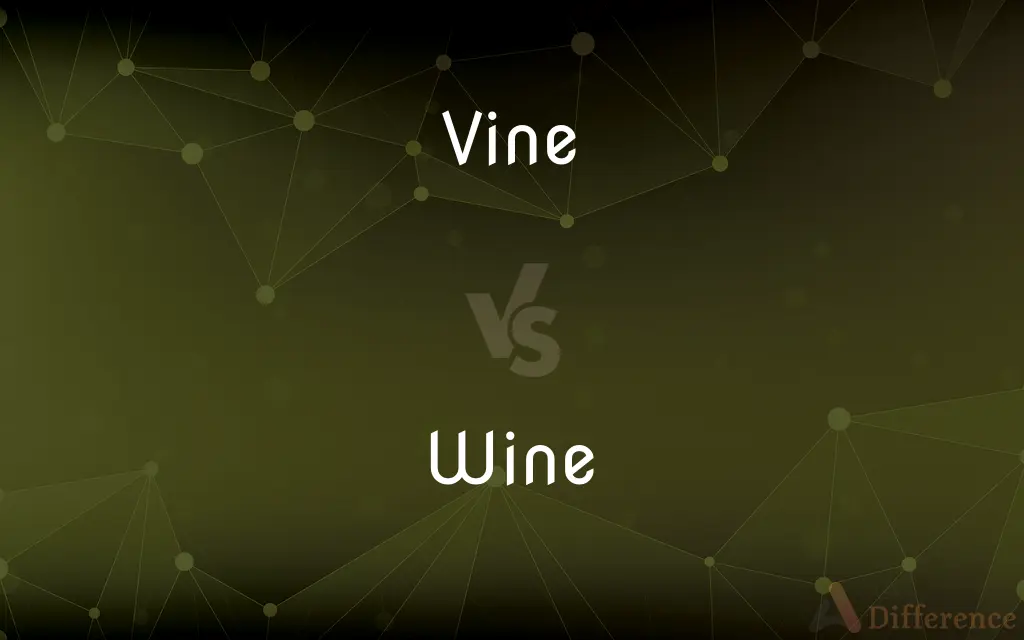Vine vs. Wine — What's the Difference?
By Tayyaba Rehman & Urooj Arif — Updated on March 19, 2024
Vine is a climbing plant producing grapes, while wine is an alcoholic beverage made from fermented grape juice.

Difference Between Vine and Wine
Table of Contents
ADVERTISEMENT
Key Differences
A vine refers to any climbing or trailing plant, with some species like the grapevine (Vitis vinifera) being cultivated for their fruit, which is used in winemaking. Whereas wine is an alcoholic drink produced through the fermentation of grape juice, a process that involves the conversion of the grapes' sugars into alcohol by yeast. The distinction lies not only in their nature—one being a plant and the other a beverage—but also in their role in agriculture and gastronomy.
While vines can grow in a variety of climates and soils, thriving particularly well in temperate regions, wine production is an art that varies depending on the grape variety, region, and winemaking techniques. This means the type of vine, the quality of its grapes, and the method of cultivation directly influence the taste, aroma, and quality of the wine produced. This interconnection showcases the deep relationship between the vine as a plant and wine as its crafted product.
The cultivation of vines for winemaking, known as viticulture, is a meticulous process that involves careful selection of grape varieties, pruning, canopy management, and pest control to produce the highest quality grapes. On the other hand, winemaking (oenology) involves selecting the right blend of grapes, fermenting the juice, and aging the wine to achieve desired flavors. The processes behind vine cultivation and wine production highlight the skills and knowledge required in both fields to produce fine wine.
Vines also have ecological and aesthetic values beyond winemaking. They can provide cover, shade, and habitat for various species, and are often used in gardens and landscapes for their decorative leaves and fruits. Conversely, wine has cultural, social, and economic significance. It is not only a beverage enjoyed worldwide for its variety and complexity but also an important part of many cultures' culinary traditions, contributing significantly to the economy of wine-producing regions.
The relationship between vine and wine is intrinsic and symbiotic. The vine provides the raw material for wine, which in turn reflects the characteristics of the vine and the terroir in which it was grown. Both play significant roles in their respective domains—agriculture and gastronomy—demonstrating the connection between the natural world and human craftsmanship.
ADVERTISEMENT
Comparison Chart
Nature
Climbing or trailing plant, especially grapevines for winemaking.
Alcoholic beverage made from fermented grape juice.
Purpose
Cultivated for fruits (grapes) used in winemaking and other purposes.
Produced for consumption, enjoying its varied flavors and aromas.
Cultivation/Production
Involves viticulture practices like selection, pruning, and pest control.
Involves oenology, including fermentation, blending, and aging processes.
Significance
Has ecological and aesthetic value beyond agriculture.
Holds cultural, social, and economic significance in many societies.
Interconnection
Provides the raw material (grapes) for wine production.
Reflects the characteristics of the vine and the terroir it originates from.
Compare with Definitions
Vine
Grape Production.
The vineyard was full of vines heavy with grapes ready for harvest.
Wine
Cultural Importance.
Wine plays a central role in many cultures' dining and celebratory traditions.
Vine
Agricultural Significance.
Vines are pruned annually to ensure a good yield of quality grapes.
Wine
Economic Impact.
The wine industry significantly contributes to the economy of regions known for viticulture.
Vine
Decorative Use.
Vines are often used in landscaping for their aesthetic appeal.
Wine
Alcoholic Beverage.
The wine, aged for years, had developed a complex flavor profile.
Vine
Ecological Value.
The vine provides habitat and cover for various bird species in the vineyard.
Wine
Variety in Production.
Wine can range from dry to sweet, influenced by the grape variety and fermentation process.
Vine
Climbing Plant.
The vine wrapped around the trellis, displaying its lush, green leaves.
Wine
Gastronomy.
Pairing wine with food is an art that enhances the dining experience.
Vine
A vine (Latin vīnea "grapevine", "vineyard", from vīnum "wine") is any plant with a growth habit of trailing or scandent (that is, climbing) stems, lianas or runners. The word vine can also refer to such stems or runners themselves, for instance, when used in wicker work.In parts of the world, including the British Isles, the term "vine" usually applies exclusively to grapevines (Vitis), while the term "climber" is used for all climbing plants.
Wine
Wine is an alcoholic drink typically made from fermented grapes. Yeast consumes the sugar in the grapes and converts it to ethanol, carbon dioxide and heat.
Vine
A weak-stemmed plant that derives its support from climbing, twining, or creeping along a surface.
Wine
An alcoholic drink made from fermented grape juice
He opened a bottle of red wine
The regional foods and wines of France
Vine
The stem of such a plant.
Wine
Entertain someone by offering them drinks and a meal
Members of Congress have been lavishly wined and dined by lobbyists for years
Vine
A grapevine.
Wine
Dance with rhythmic gyratory movements of the pelvic region
The crowd jumped and wined and churned the field into mud
Vine
Grapevines considered as a group
Products of the vine.
Wine
A beverage made of the fermented juice of any of various kinds of grapes, usually containing from 10 to 15 percent alcohol by volume.
Vine
To form or develop like a vine.
Wine
A beverage made of the fermented juice of any of various other fruits or plants.
Vine
The climbing plant that produces grapes.
They picked the grapes off the vine.
Wine
Something that intoxicates or exhilarates.
Vine
Any plant of the genus Vitis.
Wine
The color of red wine.
Vine
(by extension) Any similar climbing or trailing plant.
Wine
To provide or entertain with wine.
Vine
Any woody climbing plant which bears grapes.
There shall be no grapes on the vine.
And one went out into the field to gather herbs, and found a wild vine, and gathered thereof wild gourds.
Wine
To drink wine.
Vine
Weak-stemmed plant that derives support from climbing, twining, or creeping along a surface
Wine
An alcoholic beverage made by fermenting grape juice, with an ABV ranging from 5.5–16%.
Wine is usually stronger than beer.
"Wine improves with age but I improve with wine," she slurred as she slid gracefully beneath the table.
Wine
An alcoholic beverage made by fermenting other substances, producing a similar ABV.
...dandelion wine, rice wine, plum wine...
Wine
(countable) A serving of wine.
I'd like three beers and two wines, please. My friend will have the same.
Wine
(uncountable) The color of red wine, a deep reddish purple.
Wine
Wind.
Wine
(transitive) To entertain with wine.
Wine
(intransitive) To drink wine.
Wine
The expressed juice of grapes, esp. when fermented; a beverage or liquor prepared from grapes by squeezing out their juice, and (usually) allowing it to ferment.
Wine is a mocker, strong drink is raging, and whosoever is deceived thereby is not wise.
Bacchus, that first from out the purple grapeCrushed the sweet poison of misused wine.
Wine
A liquor or beverage prepared from the juice of any fruit or plant by a process similar to that for grape wine; as, currant wine; gooseberry wine; palm wine.
Wine
The effect of drinking wine in excess; intoxication.
Noah awoke from his wine.
Wine
Fermented juice (of grapes especially)
Wine
A red as dark as red wine
Wine
Drink wine
Wine
Treat to wine;
Our relatives in Italy wined and dined us for a week
Common Curiosities
What is a vine?
A vine is a type of climbing or trailing plant, with grapevines specifically cultivated for winemaking.
How is wine made?
Wine is made by fermenting crushed grapes using yeast, which converts the grapes' sugars into alcohol.
What is the significance of wine in culture?
Wine holds significant cultural value in many societies, often associated with tradition, celebration, and gastronomy.
What is terroir?
Terroir refers to the environmental conditions, especially soil and climate, in which vines are grown and that give a wine its unique flavor.
Can vines grow anything besides grapes?
Yes, the term "vine" can refer to any climbing plant, not just grapevines, but grapevines are most commonly associated with wine production.
What is viticulture?
Viticulture is the science, cultivation, and study of grapevines, primarily for the purpose of winemaking.
Are all wines made from grapes?
While most traditional wines are made from grapes, there are wines made from other fruits and plants.
What's the difference between red and white wine production?
The main difference lies in the fermentation process; red wine is fermented with the grape skins, giving it color and tannins, while white wine is fermented without skins.
How does the climate affect vine growth?
Climate affects grape ripening, sugar content, and acidity, which in turn influence wine quality and character.
What factors affect wine quality?
Wine quality can be affected by the grape variety, vineyard location (terroir), winemaking techniques, and aging process.
How long can a vine live?
Some grapevines can live and produce fruit for over 100 years, with proper care and conditions.
Can the same vine produce different types of wine?
Yes, the same grape variety can produce different styles of wine depending on the winemaking process and conditions.
Is organic wine production different?
Yes, organic wine is made from grapes grown without synthetic pesticides or fertilizers, and with minimal chemical intervention during winemaking.
Can vines be grown indoors?
While challenging, it's possible to grow vines indoors with sufficient light, space, and care, though this is not common for commercial winemaking.
Share Your Discovery

Previous Comparison
Conjugation vs. Hyperconjugation
Next Comparison
Semantics vs. PragmaticsAuthor Spotlight
Written by
Tayyaba RehmanTayyaba Rehman is a distinguished writer, currently serving as a primary contributor to askdifference.com. As a researcher in semantics and etymology, Tayyaba's passion for the complexity of languages and their distinctions has found a perfect home on the platform. Tayyaba delves into the intricacies of language, distinguishing between commonly confused words and phrases, thereby providing clarity for readers worldwide.
Co-written by
Urooj ArifUrooj is a skilled content writer at Ask Difference, known for her exceptional ability to simplify complex topics into engaging and informative content. With a passion for research and a flair for clear, concise writing, she consistently delivers articles that resonate with our diverse audience.













































